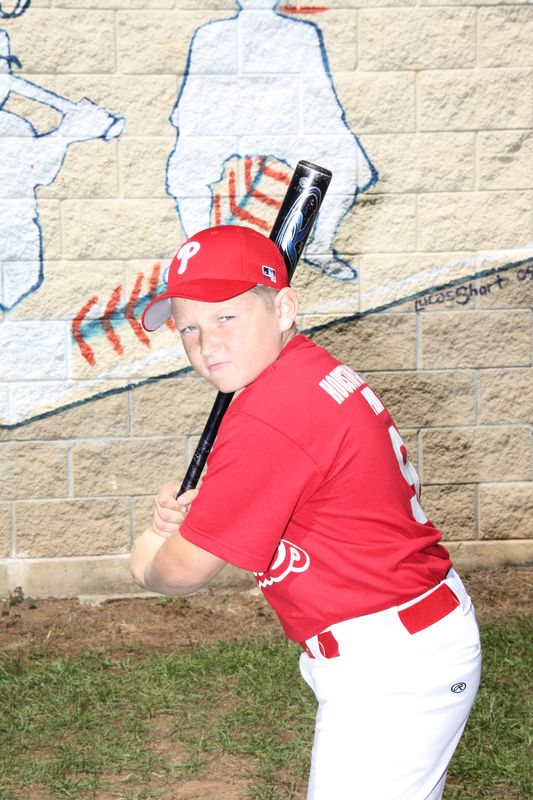Need on-camera flash help.
May 10, 2012 09:41:18 #
I am shooting individual babseball players in a sunny situation and need to use some fill-flash to fill in under the hat. I used manual minus 2 stops, but that blew them away and I tried ETTL and that over exposed them too...What do you suppose I ought to do?
See, the highlights are blown

May 10, 2012 16:41:11 #
wtw2143
Loc: West Hempstead, NY
I would shoot in AV mode with no exposure compensation but would set the flash exposure compensation to somewhere between -1 to -2. Also you may need to set the flash to high speed sync if your shutter speed is over 1/250. Try it and see what you get!
Win
Win
May 10, 2012 17:33:18 #
This is not a bad shot, and I am assuming that it was taken with the manual setting as described. If so I would adjust your aperture by one or two stops. The image is washed out just a little. If you are doing post production just adjust the exposure until your skin tones fall into place. Again I am assuming many thing, however a correct exposure is not fair form reach.
May 11, 2012 08:55:43 #
This is a decent shot, it's just a little hot. This is what I would try. I know some kids like to have their hats pulled way down (not this guy) but some. Have them lift it up a bit, it will still look ok, and you won't have to try and light them up from the bottom which never looks normal.
Anyway,,,set exposure for the ambient light (outside) using either a hand held meter or your cameras metering system. Then put those settings into your camera in manual mode.
Set your flash in manual also,(since your subjects will be photographed in the same spot I'm assuming). Either meter or take some test shots, adjusting your manual flash output (or move the flash if it's on a stand) until it is right for your subject. You could leave your flash in (E)TTL mode, but you run the risk of varying flash output.
Now your settings stay the same for subject after subject. That's how I do sports pics.
Anyway,,,set exposure for the ambient light (outside) using either a hand held meter or your cameras metering system. Then put those settings into your camera in manual mode.
Set your flash in manual also,(since your subjects will be photographed in the same spot I'm assuming). Either meter or take some test shots, adjusting your manual flash output (or move the flash if it's on a stand) until it is right for your subject. You could leave your flash in (E)TTL mode, but you run the risk of varying flash output.
Now your settings stay the same for subject after subject. That's how I do sports pics.
May 11, 2012 09:33:09 #
If your camera has a portrait mode this will compensate the correct exposure. I'm usually in the manual mode for all my shooting, but there are times when other modes do come in handy.
May 11, 2012 09:37:37 #
Doing flash photography involves 2 exposures -- one for the ambient lighting, and one for the flash lighting.
Once you understand the necessity of making 2 settings for an exposure involving flash lighting, then you will gain the exposure control you seek.
Note that you will have more control with Manual mode settings for Shutter Speed and Aperture.
Here's one way. Set your camera for properly exposing the overall lighting (with the flash unit shut off). At this point, the main subject may appear underexposed. But continue. Check the Histogram to ensure this ambient lighting exposure stays within the range of the Histogram.
Next, turn on the flash unit. The flash lighting will illuminate your main subject. So adjust only the flash lighting output. Do so by having your flash unit set to Manual mode. In the Manual mode, you can set the flash power level to expose the main subject correctly.
You may have to take a few test shots before reaching the desired amount of flash lighting on the main subject.
Some photographers, despite their experience doing photography, still need to learn how the flash lighting and the ambient lighting work together.
Consider how the Shutter Speed controls the amount of photons falling on the sensor by leaving the shutter open for a set time. The sensor captures photons during this period.
Flash lighting occurs at the beginning at the period. But the flash lighting happens only during a very short part of this period -- typically for about 1/1000th second (although it will last a much shorter time at a low flash unit power setting).
After the flash lighting ends, the shutter stays open for the remainder of the duration of the exposure in order to record the ambient lighting.
This two-part mechanical operation determines the final exposure.
Good luck.
Once you understand the necessity of making 2 settings for an exposure involving flash lighting, then you will gain the exposure control you seek.
Note that you will have more control with Manual mode settings for Shutter Speed and Aperture.
Here's one way. Set your camera for properly exposing the overall lighting (with the flash unit shut off). At this point, the main subject may appear underexposed. But continue. Check the Histogram to ensure this ambient lighting exposure stays within the range of the Histogram.
Next, turn on the flash unit. The flash lighting will illuminate your main subject. So adjust only the flash lighting output. Do so by having your flash unit set to Manual mode. In the Manual mode, you can set the flash power level to expose the main subject correctly.
You may have to take a few test shots before reaching the desired amount of flash lighting on the main subject.
Some photographers, despite their experience doing photography, still need to learn how the flash lighting and the ambient lighting work together.
Consider how the Shutter Speed controls the amount of photons falling on the sensor by leaving the shutter open for a set time. The sensor captures photons during this period.
Flash lighting occurs at the beginning at the period. But the flash lighting happens only during a very short part of this period -- typically for about 1/1000th second (although it will last a much shorter time at a low flash unit power setting).
After the flash lighting ends, the shutter stays open for the remainder of the duration of the exposure in order to record the ambient lighting.
This two-part mechanical operation determines the final exposure.
Good luck.
May 11, 2012 13:23:25 #
This is a nice shot and I agree with the above comments. It is a bit hot. If possible try working without flash by using a tripod and Remote release with reflectors of Gold or Silver, if possible, or an umbrella or both. Good shot Do we look for this guy on a BB Card??
Ray
Ray
May 11, 2012 15:56:38 #
Nice Shot, I see what you mean, shadows in the face and when you tried with the flash the white pants are blown out... I think the best , someone already mentioned is use a reflector to bounce the light under the hat or different time of day
May 11, 2012 16:33:17 #
May 11, 2012 17:02:23 #
I think you have this shot pretty much right. Just go to manual on the camera and your flash like I suggested. Your exposures will not only stay consistent, but you'll use less battery power, less wear on your flash in general, and the recycle time will be faster.
Doing baseball teams, you will almost certainly find yourself in the bright sun, with no open shade around. It looks like that is the case here, and you did well. I wouldn't recommend using any auto settings (camera or flash) in bright sun. You are better off in manual.
A little shadowing does wonders. Just nail the exposure. Doing dozens of them one right after the other, you need to be consistent (for post and printing), and going manual in the camera and on the flash will gaurantee that.
Doing baseball teams, you will almost certainly find yourself in the bright sun, with no open shade around. It looks like that is the case here, and you did well. I wouldn't recommend using any auto settings (camera or flash) in bright sun. You are better off in manual.
A little shadowing does wonders. Just nail the exposure. Doing dozens of them one right after the other, you need to be consistent (for post and printing), and going manual in the camera and on the flash will gaurantee that.
May 11, 2012 17:07:56 #
anotherview wrote:
Doing flash photography involves 2 exposures -- on... (show quote)
Great explanation. Thanks
:thumbup:
May 11, 2012 17:10:25 #
skidooman wrote:
This is a decent shot, it's just a little hot. Thi... (show quote)
This is the correct advice.
Manual flash on a stand.
Meter to get a proper exposure for the available light
Meter the flash to match or pop a few test shots to match.
Adjust the shutter speed to set the amount of ambient light wanted.
Take all the shots you want perfectly exposed.
May 11, 2012 17:25:35 #
rpavich wrote:
quote=skidooman This is a decent shot, it's just ... (show quote)
I figured since the OP is a wedding/portrait photographer, I'd try to make it short and sweet. You did it in 6 sentences. Nicely done. :)
May 11, 2012 17:36:04 #
skidooman wrote:
I figured since the OP is a wedding/portrait photographer, I'd try to make it short and sweet. You did it in 6 sentences. Nicely done. :))
I figured since the OP is a wedding/portrait photographer, I'd try to make it short and sweet. You did it in 6 sentences. Nicely done. :))
Well..I was just building on what you said with more detail. :)
May 11, 2012 17:37:30 #
anotherview wrote:
Doing flash photography involves 2 exposures -- on... (show quote)
Everyone who wants to use flash should read this post several times until it sinks in...
This should be a sticky...read it...absorb it...fire that speedlight up!
If you want to reply, then register here. Registration is free and your account is created instantly, so you can post right away.








